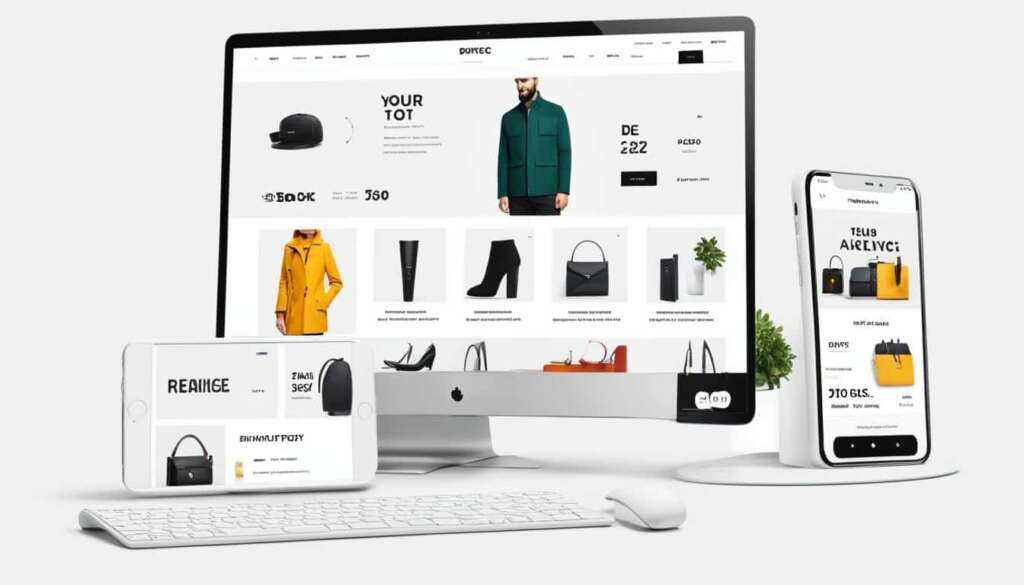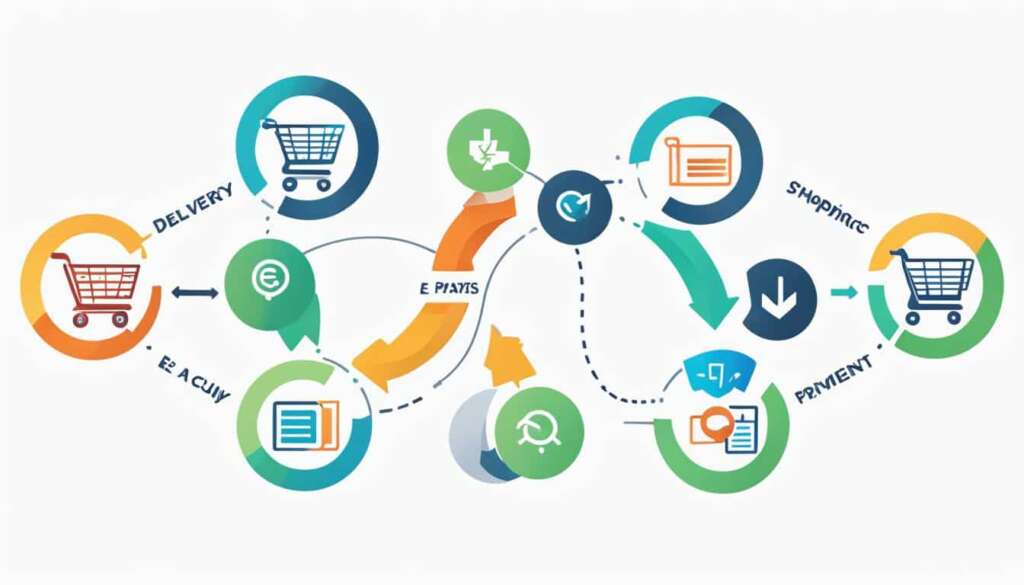Table of Contents
The fashion and apparel industry holds significant power in the e-commerce space, with 13 of the top 20 direct-to-consumer (DTC) brands belonging to this sector. Digital innovation, globalization, and changes in consumer spending habits have caused the fashion industry to undergo major shifts. However, inflation and supply chain pressures make the sector more unpredictable than ever.
Despite these challenges, there are several growth opportunities for fashion retailers in the e-commerce space. Personalization, the metaverse, brand-building, sustainability, social commerce, and the transition back to brick-and-mortar are some of the latest trends shaping the industry.
Additionally, the resale market for secondhand apparel is rapidly growing, with North American consumers leading the trend. Fashion brands are taking notice and launching their own resale programs. The importance of personalization in e-commerce cannot be overstated, but brands must be careful not to overdo it.
The concept of the metaverse, where virtual reality and augmented reality technologies are used for daily activities, is gaining traction in the fashion industry. Fashion brands are also focusing on sustainability and ethical sourcing to cater to consumers who prioritize eco-friendly products. Social media plays a crucial role in the marketing strategy of fashion e-commerce brands. With the rise of mobile shopping, an omnichannel approach is essential for success in the fashion industry.
Stay tuned for the upcoming sections of this article, where we will dive deeper into the rise of secondhand apparel, the power of personalization, the emergence of the metaverse, the focus on sustainability, and the role of social commerce in the e-commerce fashion industry.
The Rise of Secondhand Apparel and Resale Platforms
The resale market for secondhand apparel is experiencing significant growth, with a 24% increase in 2022 alone. It is projected to reach a market valuation of $218 billion by 2026. The North American market is driving this trend, with the secondhand apparel market growing eight times faster than the overall apparel market. Technology and online marketplaces have made it easier for consumers to shop secondhand. As a result, nearly one billion new clothing purchases were displaced by secondhand sales in 2021.
Fashion brands are recognizing the potential of the resale market and launching their own resale programs. For example, Dôen, a California-based premium fashion brand, is launching a program called Hand Me Dôen, which allows customers to send in pre-owned Dôen products in exchange for store credit. Shein, a fast fashion brand, is also entering the resale market. However, there is skepticism about whether fast fashion brands can succeed in the resale market. Despite this, the resale market is expected to continue growing and presents opportunities for both luxury and fast-fashion brands.
Sustainable fashion is in demand, and the resale market offers consumers the chance to shop for trendy and affordable clothing while reducing their environmental impact. As more consumers seek sustainable alternatives, fashion brands that prioritize secondhand apparel and embrace the resale market can tap into a growing customer base.
To illustrate the growth of the resale market for secondhand apparel, the following table provides a comparison of the total market size for secondhand apparel in selected regions:
| Region | Market Valuation (2021) | Projected Growth Rate |
|---|---|---|
| North America | $18 billion | 26% |
| Europe | $20 billion | 22% |
| Asia-Pacific | $14 billion | 28% |
| Latin America | $6 billion | 30% |
| Middle East and Africa | $3 billion | 18% |
As the table demonstrates, the North American market currently leads in terms of market valuation, but other regions, such as Europe and Asia-Pacific, are also experiencing significant growth. The increasing popularity of secondhand apparel offers fashion brands the chance to diversify their revenue streams and attract environmentally-conscious consumers who prioritize sustainability.
The Power of Personalization in E-Commerce Fashion
Personalization has been a key driver of success in the e-commerce fashion industry. By tailoring the online shopping experience to individual customers, brands have the ability to significantly increase conversion rates and create a more engaging customer experience.
According to Shopify research, 44% of customers are comfortable with brands using their personal information to personalize messaging and enhance the overall customer experience. This showcases the growing acceptance of personalization as a valuable marketing strategy.
However, it is important for brands to strike a balance between personalization and privacy concerns. Overwhelming customers with excessive personalization can be off-putting and may lead to higher abandonment rates. Brands must respect privacy boundaries and ensure that customers feel comfortable and in control of their data.
“Personalization is about crafting a tailored experience for customers that meets their individual needs and preferences. It’s a powerful tool for creating lasting connections and driving customer loyalty.”
Culture Kings, a prominent e-commerce fashion brand, serves as an excellent example of achieving this balance effectively. The brand has created four global storefronts to cater to different currencies, providing customers with a personalized shopping experience that suits their specific needs. As a result, over half of Culture Kings’ revenue comes from their e-commerce business.
In the future, it is predicted that more local fashion brands will embrace personalization to offer customized shopping experiences for international customers. This will enable them to remain competitive in the ever-evolving e-commerce fashion industry.
The Benefits of Personalization in E-Commerce Fashion
Personalization brings numerous benefits to e-commerce fashion brands and their customers:
- Enhanced customer experience: Personalized product recommendations, tailored offers, and customized content create a more enjoyable and relevant shopping experience for customers.
- Increased customer loyalty: By understanding and meeting customers’ unique preferences, brands can foster stronger relationships and encourage repeat purchases.
- Improved conversion rates: Personalization helps brands effectively target customers with relevant products and offers, leading to higher conversion rates and increased sales.
Personalization is a powerful tool that can transform the e-commerce fashion industry. By leveraging customer data responsibly and providing tailored experiences, brands can stay ahead of the competition and deliver exceptional customer satisfaction.
| Benefits of Personalization in E-Commerce Fashion | |
|---|---|
| Enhanced customer experience | Improved conversion rates |
| Increased customer loyalty |
The Emergence of the Metaverse in Fashion
The fashion industry is constantly evolving, and one of the latest trends making waves is the emergence of the metaverse. This concept involves the use of virtual reality (VR) and augmented reality (AR) technologies to create a digital universe where people can engage in various activities. In the context of the fashion industry, the metaverse offers exciting possibilities for brands to engage with customers in immersive and interactive ways.
Imagine being able to virtually try on clothes, attend fashion shows, or visit virtual fashion stores without leaving your home. This is the future that the metaverse promises for the fashion industry.
One key element of the metaverse is the use of non-fungible tokens (NFTs). These unique digital assets are becoming increasingly popular among consumers who value authenticity and exclusivity. Fashion brands are starting to experiment with NFTs, offering digital collectibles and experiences that are tied to their physical products.
For example, sports apparel brand Under Armour recently released digital NFTs alongside the physical launch of shoes worn by basketball star Steph Curry. This unique combination allowed fans to own a piece of digital memorabilia while also owning the physical product.
The integration of NFTs and virtual reality experiences opens up new opportunities for fashion brands to engage with their audience and create memorable interactions.
Another notable example is Forever 21’s partnership with Roblox, a popular online gaming platform. Together, they created virtual fashion e-commerce stores within the Roblox metaverse. Users can browse and purchase virtual clothing items for their avatars, blurring the lines between real and digital fashion experiences.
As the world becomes increasingly digitized, the adoption of metaverse technologies in the fashion industry is expected to accelerate. Fashion brands are exploring ways to harness the power of VR, AR, and NFTs to create unique and immersive experiences for their customers.
“The metaverse represents an exciting frontier for the fashion industry, opening up new avenues for creativity, self-expression, and consumer engagement. It has the potential to revolutionize the way we experience and interact with fashion.”
Fashion Brands Embracing the Metaverse
| Brand | Metaverse Initiatives |
|---|---|
| Under Armour | Released digital NFTs alongside physical product launches |
| Forever 21 | Partnered with Roblox to create virtual fashion e-commerce stores |
| [Brand Name] | [Initiative] |

In conclusion, the metaverse represents an exciting frontier for the fashion industry. Through the use of virtual reality, augmented reality, and non-fungible tokens, fashion brands can create immersive and interactive experiences for their customers. The adoption of metaverse technologies is expected to continue growing as more brands recognize the potential for enhancing customer engagement and creating unique digital fashion experiences.
Sustainability as a Key Focus in Fashion E-Commerce
Sustainability has become a major focus in the fashion industry, driven by increasing consumer demand and the urgent need to address environmental concerns. Research indicates that 42% of customers worldwide are actively purchasing eco-friendly and sustainable products, demonstrating a significant shift towards conscious shopping habits. In particular, countries like Vietnam, India, and the Philippines lead the way in sustainable product purchases, showcasing a global commitment to sustainability in the fashion industry.
The COVID-19 pandemic has further emphasized the importance of sustainability, as customers now prioritize the longevity and durability of fashion items. With a desire to reduce waste and promote a circular economy, individuals are opting to keep their existing clothing items for longer and invest in more durable pieces. This change in consumer behavior is a positive step towards sustainability in the fashion sector.
The resale market has also gained immense momentum as a sustainable alternative to traditional buying practices. Brands like Patagonia are actively promoting sustainability by offering programs like Worn Wear, enabling customers to buy and sell used items. By embracing the resale market, fashion brands not only contribute to reducing waste but also provide an avenue for sustainable fashion choices.
“Sustainability is no longer just a trend—it’s a necessary shift towards a more responsible and ethical fashion industry. Brands that prioritize sustainability will not only benefit the planet but also gain a competitive edge in the e-commerce fashion landscape.”
This trend towards sustainability is expected to continue as consumers become increasingly conscious of their impact on the environment. Brands that embrace sustainable practices, such as ethical sourcing and manufacturing processes, reduced carbon emissions, and circular fashion initiatives, will have a distinct competitive advantage in the e-commerce fashion industry.
By aligning with consumer values and actively contributing to a more sustainable future, fashion e-commerce brands can foster trust, enhance their brand reputation, and attract a loyal customer base. Sustainability is no longer an option but a necessity for the long-term success of the fashion industry.
| Country | Percentage of Customers Purchasing Sustainable Products |
|---|---|
| Vietnam | 58% |
| India | 52% |
| Philippines | 47% |
The Role of Social Commerce in Fashion E-Commerce
Social media platforms play a significant role in the marketing strategies of fashion e-commerce brands. With people spending a significant amount of time on social media, brands are leveraging these platforms to reach their target audience. Social commerce, which involves selling products directly through social media platforms, is becoming more prevalent.
Platforms like Instagram and Facebook offer e-commerce features that allow brands to showcase their products and make it easier for consumers to make purchases. By incorporating social commerce into their e-commerce strategies, fashion brands can reach a wider audience and increase sales.
Here are some key benefits of social commerce in the fashion industry:
- Increased visibility: Social media platforms have millions of active users, providing fashion brands with a vast pool of potential customers. By utilizing social commerce, brands can tap into this large audience and increase their visibility.
- Direct engagement: Social media allows brands to engage directly with their audience through comments, messages, and live chats. This level of interaction creates a personalized shopping experience and builds customer loyalty.
- Seamless shopping experience: With social commerce, consumers can discover and purchase products without leaving the platform. This streamlined process eliminates the need for multiple browser tabs or apps, making online shopping more convenient.
In addition to these benefits, social commerce can also leverage user-generated content, influencer marketing, and social proof to enhance brand credibility and trust.
“Social commerce is revolutionizing the way fashion brands connect with consumers. By integrating e-commerce features directly into social media platforms, brands can reach customers in a more personalized and convenient manner.” – Fashion Marketing Expert
The table below showcases the popularity and impact of social commerce in the fashion industry:
| Fashion Brand | Social Commerce Platform | Benefits |
|---|---|---|
| Zara | Increased brand visibility and direct engagement | |
| ASOS | Seamless shopping experience and influencer collaborations | |
| Gucci | TikTok | Viral marketing campaigns and user-generated content |

As the fashion industry continues to evolve, incorporating social commerce into e-commerce strategies has become essential for brands to stay competitive. By leveraging the reach and engagement of social media platforms, fashion brands can create a seamless and personalized shopping experience for their customers, ultimately leading to increased sales and brand loyalty.
Conclusion
The e-commerce fashion industry is undergoing significant growth and transformation, fueled by digital innovation, globalization, and evolving consumer preferences. Although the sector faces challenges such as supply chain disruptions and fierce competition, it also presents abundant opportunities for expansion and success. Key market trends encompass personalization, the emergence of the metaverse, sustainability, social commerce, and the rise of secondhand apparel. Brands that proactively embrace these trends and adapt to the ever-changing landscape of e-commerce fashion will position themselves favorably for the future.
The future of the fashion industry lies in its ability to evolve and meet the demands of today’s consumers. Personalization, leveraging cutting-edge technologies, plays a crucial role in enhancing customer experience and driving conversion rates. Additionally, the rise of the metaverse offers innovative ways for brands to connect with their audience through virtual reality and augmented reality experiences.
Sustainability is another key focus, with consumers increasingly seeking eco-friendly and ethical options. Fashion brands that emphasize sustainability and employ ethical sourcing practices will enjoy a competitive edge in the e-commerce fashion industry. Social commerce, leveraging the power of social media platforms, enables brands to reach a broader audience and facilitate seamless online shopping experiences.
The market trend of the resale market for secondhand apparel is also gaining traction, providing fashion brands with the opportunity to tap into this growing sector. By exploring these market trends and adapting their strategies, fashion brands can navigate the ever-changing landscape of e-commerce fashion and secure a prosperous future in the industry.
FAQ
What are the key market trends in the e-commerce fashion industry?
The key market trends in the e-commerce fashion industry include personalization, the emergence of the metaverse, sustainability, social commerce, and the rise of secondhand apparel.
What is the significance of secondhand apparel and resale platforms in the fashion industry?
Secondhand apparel and resale platforms are gaining importance in the fashion industry as they offer sustainable alternatives to buying new clothing. The resale market is growing rapidly, presenting opportunities for both luxury and fast fashion brands.
How does personalization impact the success of e-commerce fashion?
Personalization plays a crucial role in the success of e-commerce fashion. By tailoring the online shopping experience to individual customers, brands can increase conversion rates. However, brands must strike a balance between personalization and privacy concerns.
What is the metaverse and how is it relevant to the fashion industry?
The metaverse is a concept where people can conduct daily activities using virtual reality and augmented reality technology. It is gaining traction in the fashion industry, with fashion brands experimenting with non-fungible tokens (NFTs) and virtual reality experiences.
Why is sustainability a growing focus in the fashion industry?
Sustainability is a growing focus in the fashion industry due to consumer demand and environmental concerns. Customers are purchasing more eco-friendly and sustainable products, and the resale market has gained momentum as a sustainable alternative to buying new clothing.
What role does social commerce play in fashion e-commerce?
Social media platforms play a significant role in the marketing strategies of fashion e-commerce brands. Social commerce, which involves selling products directly through social media platforms, is becoming more prevalent. Platforms like Instagram and Facebook offer e-commerce features that allow brands to showcase their products and increase sales.













